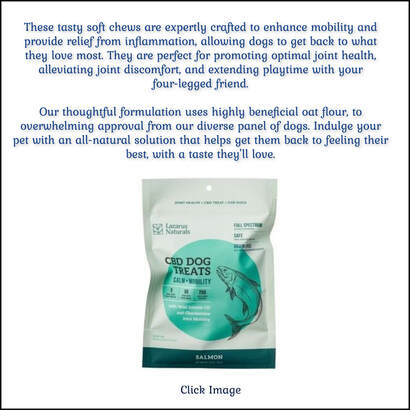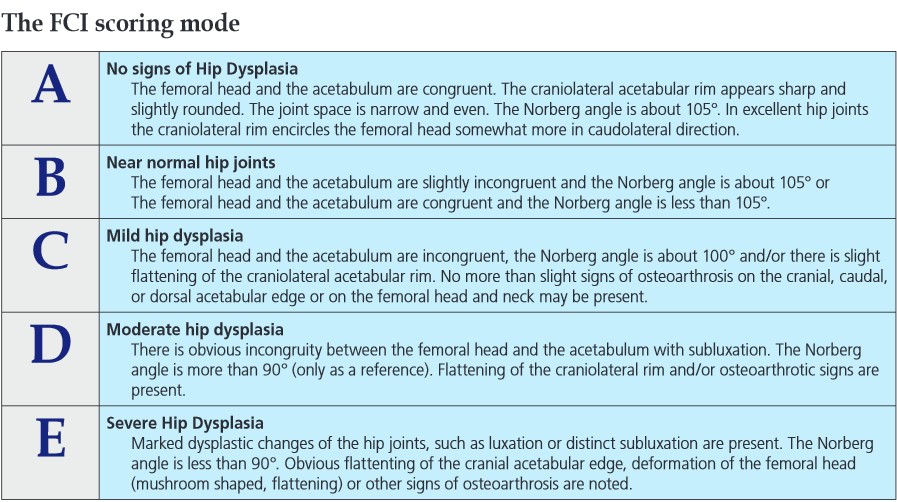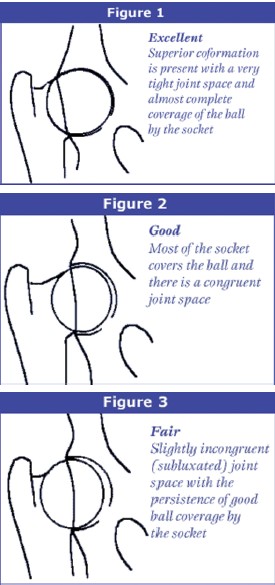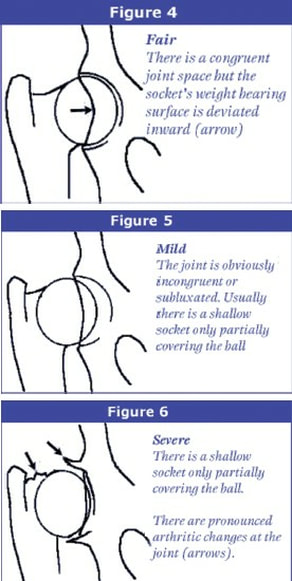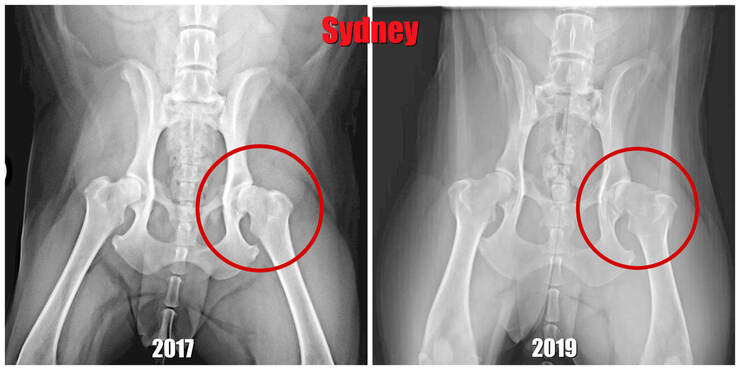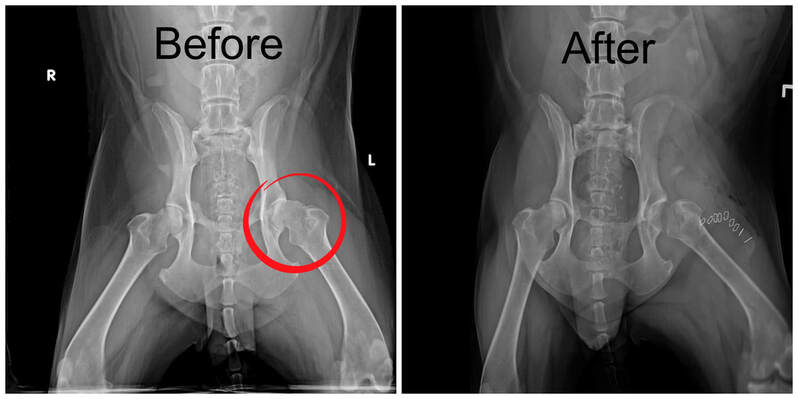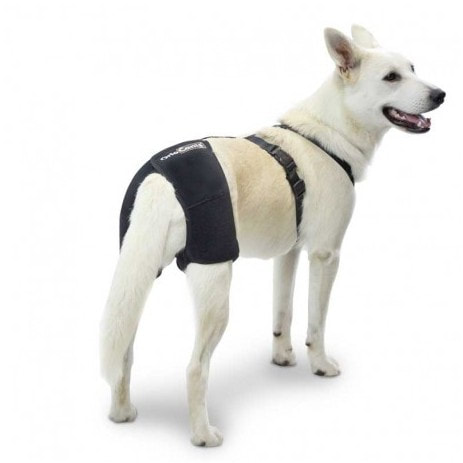Confirmation of hip dysplasia requires quality hip radiographs, which should be done under sedation or general anesthesia to achieve proper positioning. X-rays taken on an awake patient may lead to an erroneous diagnosis.
By Natural Dog Health Remedies
Hip dysplasia is one form of arthritis. It refers to the abnormal growth or development of the ball and socket joint of the hips of dogs. This page looks at the symptoms and causes of canine hip dysplasia, as well as some natural remedies such as herbs, vitamins, and supplements that can be used as a complementary treatment option.
In a healthy dog, the upper end of the thighbone (which is shaped like a ball) fits snugly into the socket of the hipbone, and the ball rotates freely, smoothly, and painlessly within the socket. The thighbone and the hipbone are shaped in such a way that they fix into each other perfectly to facilitate smooth movement. To strengthen the joint, the two bones are held together by a strong ligament. In addition, there is a very strong band of connective tissue which encircles the two bones to provide further stability.
Hip dysplasia in dogs is essentially a deformity of the hip joint. In a dog with hip dysplasia, the hip socket may be too shallow to fully and firmly hold the ball-shaped thighbone, or the muscles, ligament, and connective tissue surrounding the joint may not be strong enough to hold the "ball and socket" together. This results in pain and inflammation in one or both of the hip joints, causing difficulty for the dog to get up and walk with ease.
Hip dysplasia is one form of arthritis. It refers to the abnormal growth or development of the ball and socket joint of the hips of dogs. This page looks at the symptoms and causes of canine hip dysplasia, as well as some natural remedies such as herbs, vitamins, and supplements that can be used as a complementary treatment option.
In a healthy dog, the upper end of the thighbone (which is shaped like a ball) fits snugly into the socket of the hipbone, and the ball rotates freely, smoothly, and painlessly within the socket. The thighbone and the hipbone are shaped in such a way that they fix into each other perfectly to facilitate smooth movement. To strengthen the joint, the two bones are held together by a strong ligament. In addition, there is a very strong band of connective tissue which encircles the two bones to provide further stability.
Hip dysplasia in dogs is essentially a deformity of the hip joint. In a dog with hip dysplasia, the hip socket may be too shallow to fully and firmly hold the ball-shaped thighbone, or the muscles, ligament, and connective tissue surrounding the joint may not be strong enough to hold the "ball and socket" together. This results in pain and inflammation in one or both of the hip joints, causing difficulty for the dog to get up and walk with ease.
|
Hip dysplasia in dogs is a condition that can range from just a slight abnormality in the hip joint to the actual dislocation of the joint.
All dogs, young and old, can develop hip dysplasia. However, large breed growing puppies are more prone to develop this joint problem. In extreme cases, very young puppies (around 5 months of age) will start showing signs and symptoms (e.g. limping) during and after vigorous exercise. As time goes on and without medical treatment, these dogs may develop degeneration of the joint, arthritis, inflammation and pain. In serious cases, the dogs may not be able to walk at all. However, more often than not, the symptoms do not start showing until the dog becomes older. |
|
Possible Causes of Hip Dysplasia in Dogs
Heredity Many veterinarians believe that hip dysplasia in dogs is caused by heredity. Some breeds of large dogs, such as German Shepherds, St. Bernards, Golden Retrievers, etc. are more prone to hip dysplasia. It is also said that there is a high chance that dogs with hip dysplasia will pass the condition down onto their offsprings. Over-vaccination Many holistic veterinarians believe that over-vaccination can increase the risk of developing hip dysplasia in dogs. They advise that if your dog is young and is genetically predisposed to hip dysplasia, you should consider not vaccinating every year. Diet Feeding a diet that has too much or too little calcium or other minerals can also have a detrimental effect on the development of the hip joint. In addition, vitamin deficiencies (especially vitamin C) can also cause canine hip dysplasia. Dogs who are fed low-quality commercial pet food are at higher risk of suffering from nutritional deficiencies. Feeding a dog home-made dog foods also risks nutritional imbalance and these diets must be carefully monitored to make sure that the dog is getting all the nutrients, essential minerals, and vitamins he needs. Obesity It is easy to understand that if a dog is obese, the extra weight will put more stress on the legs and joints supporting the body, thus exacerbating degeneration of the joint in a dog with hip problems. Exercise For young growing puppies especially those who are predisposed to hip dysplasia, the type and the amount of exercise is important. Any activities that put a lot of force on the joints are not good. One such activity is playing Frisbee. For dogs prone to hip dysplasia, exercise should be moderate and focused on developing, strengthening, and maintaining good muscle mass, such as running and swimming. |
|
Conventional Treatment for Hip Dysplasia
Conventional treatment includes surgery (e.g. Triple Pelvic Osteotomy, Total Hip Replacement, Femoral Head Ostectomy), and/or pain-relief and anti-inflammatory medications, weight management, and oral supplements. Natural Remedies for Dogs with Hip Dysplasia Quite a few natural remedies and supplements can be used to help repair joint tissue damage and to relieve pain and inflammation caused by the condition. Glucosamine and Chondroitin These supplements are effective for arthritis due to wear-and-tear joint deterioration both in people and dogs. MSM (Methyl-sulfonyl-methane) MSM is anti-inflammatory and is effective in relieving pain and inflammation in the joints. Fatty Acids Fatty acids are found to be effective in reducing the inflammation associated with arthritis and hip dysplasia. Vitamins C and E Pain of hip dysplasia in dogs is very often caused by inflammation both inside and surrounding the joint. Vitamins C and E have been found to reduce inflammation and cartilage damage, so it is advisable to give vitamins C and E to a dog with hip pain. Colostrum Colostrum is the protein-rich pre-milk fluid produced from a mother's mammary glands during the first 72 hours after birth. It has been found to be highly nutritious; it contains immune and growth factors, enzymes, proteins, and many other beneficial substances. Colostrum has been used by holistic veterinarians to treat a lot of dog health problems. For example, joint problems (e.g. hip dysplasia, osteoarthritis, etc,) respond well with supplementation of colostrum. The growth factors in the colostrum help facilitate the body to regenerate cells. It also helps absorption and utilization of other supplements such as glucosamine. |
|
Herbs
Keep the Dog's Weight Down Obesity can aggravate the condition of hip dysplasia in dogs. If your dog has hip dysplasia, therefore, try to keep her slim. If necessary, consult a veterinarian about putting her on a special diet or weight-loss program. Regular Exercise Exercising daily is important but not all exercises are the same. For dogs with hip dysplasia, choose exercises that can:
Examples:
If you are unsure as to which exercise is the most appropriate for your dog, consult with your veterinarian. Keep the Dog Warm and Comfortable Dogs with arthritis and hip dysplasia should be kept warm as the cold and damp will aggravate the pain. If necessary, put a sweater on your dog when going outside, and get your dog a blanket at night. A bed with good support is also important for a dog suffering from hip or joint pain. An orthopedic foam bed can help dogs with arthritis. |
|
Canine Hip Dysplasia can be diagnosed in young dogs – as early as 4 or 5 months of age. We recommend radiographs (standard and/or Pennhip Radiographs) and palpation of the hips when the pet is spayed or neutered at 5 or 6 months of age. A common misconception is waiting to obtain radiographs at 2 years of age. The Orthopedic Foundation of America recommends radiographs at 2 years of age in order to screen adult dogs for breeding purposes. A dog that is free of hip dysplasia at 2 years of age is unlikely to develop the problem and would be a good candidate for breeding. The take home message is: don’t wait to make the diagnosis – do it early to maximize the treatment options.
|
Hip Braces
**Canine Arthritis And Joint is intended for informational, educational and entertainment purposes only and is not a substitute for medical advice, diagnosis or treatment. Do not attempt to self-diagnose or treat any health condition. You should always consult with a healthcare professional before starting any diet, exercise or supplementation program, before taking any medication, or if you have or suspect your pet might have a health problem. The opinions expressed by Canine Arthritis And Joint are not to be replaced for medical care. This website and the information contained herein have not been evaluated by the Food and Drug Administration. The information and opinions on Canine Arthritis And Joint are not intended and cannot be used to diagnose, treat, cure, or prevent any disease. This applies to people and pets!
This site uses affiliate links such as banners you may see that allows for paid commissions.
This site uses affiliate links such as banners you may see that allows for paid commissions.
Canine Arthritis And Joint © Copyright 2015-2024
Designed By Paw Prints Web Design
Designed By Paw Prints Web Design


